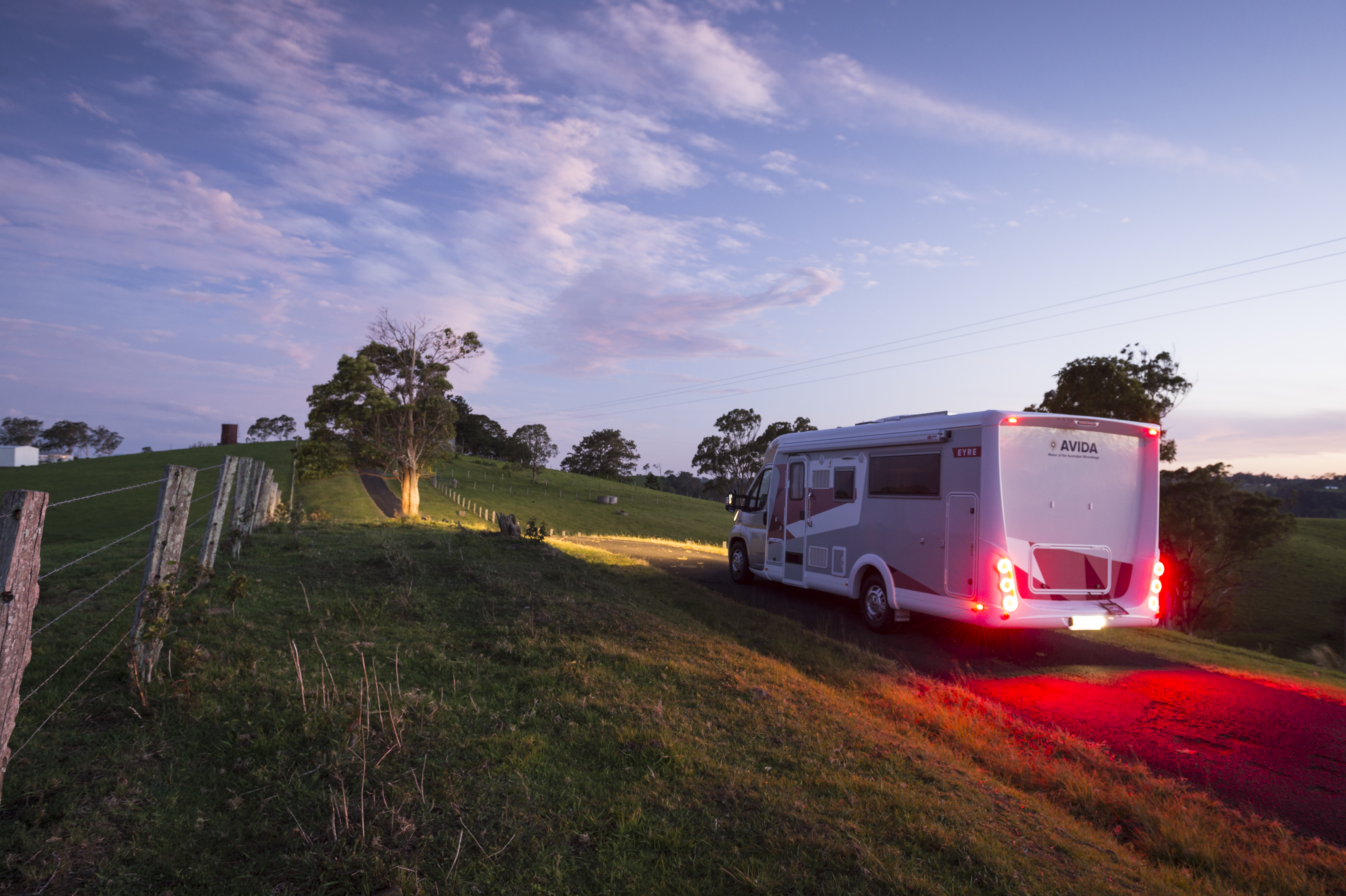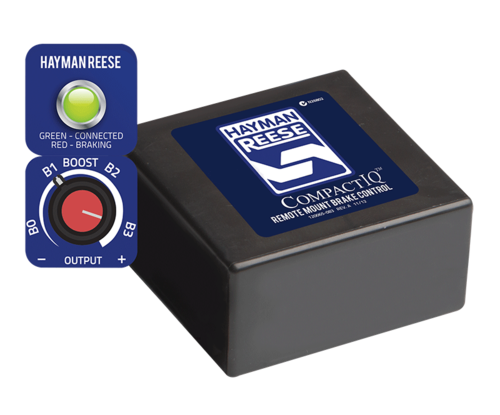Are you looking for the best caravan brake controller for your vehicle? A brake controller is essential to minimise the risk of an accident while towing your caravan.
A caravan brake controller is a crucial safety device designed to regulate the braking force applied to a towed caravan or trailer. When towing, the additional weight significantly impacts a vehicle’s ability to slow down and stop safely. Without a properly functioning electric brake controller, the caravan's momentum can push against the tow vehicle, increasing stopping distances and the risk of losing control.
The Science of Towing
When towing a caravan or trailer, physics plays a critical role in how both vehicles respond to braking and acceleration:
- Momentum: A heavier load requires more force to slow down, meaning your braking distance increases significantly compared to driving without a trailer.
- Weight Distribution: Inaccurate weight distribution or a lack of braking on the trailer can lead to trailer sway, which makes the tow vehicle unstable.
- Braking Force: Without a trailer brake system, the tow vehicle’s brakes bear the entire load, which can lead to overheating, premature wear, and even brake failure in extreme conditions.
Imagine This Scenario
You’re driving at 100 km/h on a highway, towing a caravan that weighs 2,000 kg. Suddenly, traffic ahead slows down. If your caravan lacks an electric brake controller, pressing the brakes in your vehicle won’t slow the caravan at the same rate. The force from the unbraked weight behind you could push your car forward, causing loss of control, jackknifing, or even a collision.
This situation becomes even more dangerous on steep descents or wet roads, where traction is reduced, and uncontrolled weight transfer increases the risk of skidding. A properly installed caravan brake controller ensures synchronised braking between the tow vehicle and trailer, preventing these hazardous scenarios.
How Does a Caravan Brake Controller Work?
Mounted to your tow vehicle, usually on your dash, the brake controller is used to control the electric brakes on the caravan to mimic the action of your tow vehicle brakes.
Using power from the car battery, the controller senses when you hit the brakes in the tow vehicle and sends an electric current to the electric brakes in the caravan. This activates the brakes and slows down the caravan.
Why Do You Need a Brake Controller?
A trailer brake system isn’t just a safety feature—it’s a legal requirement in Australia. The Department of Infrastructure, Transport, and Vehicles mandates that:
- Any trailer with a Gross Trailer Mass (GTM) between 750 kg and 2,000 kg must have brakes fitted on at least one axle.
- Trailers over 2,000 kg GTM require an electric brake controller on all axles for full braking capability.
With modern caravans increasing in size and weight, ensuring you have the right brake controller for your towing setup is essential for legal compliance and safety.
Australian Legal Requirements for Brake Controllers
Towing regulations in Australia are strictly enforced to ensure road safety, particularly when it comes to trailer brake systems. The Department of Infrastructure, Transport, Regional Development, and Communications sets national standards, while individual states may have additional requirements.
The legal necessity for a caravan brake controller depends on the Gross Trailer Mass (GTM) of your setup:
- 0 – 750 kg GTM: No braking system required.
- 750 – 2,000 kg GTM: Brakes must be fitted on at least one axle, which can be either mechanical override brakes or electric brakes.
- 2,000 – 4,500 kg GTM: Must have electric brakes on all wheels, controlled by a compliant electric brake controller in the tow vehicle. A breakaway system is also mandatory, ensuring the trailer’s brakes engage if it detaches from the tow vehicle.
ADR Compliance: Ensuring Your System Meets National Standards
The Australian Design Rules (ADR) govern the manufacturing and installation of brake systems, ensuring they meet performance and safety benchmarks. To be legally compliant, your caravan brake controller and associated components must align with:
- ADR 38/05: Specifies braking requirements for trailers over 4.5 tonnes but provides relevant guidelines for smaller trailers.
- ADR 31/03 & ADR 35/06: Cover compatibility between vehicle braking systems and towed trailers, ensuring synchronised and efficient braking performance.
- ADR 62/02: Outlines general construction and design requirements, including brake controller installation for safe operation.
When selecting a brake controller in Australia, ensure it is ADR compliant to meet legal obligations and avoid fines.
State Specific Variations
While ADR regulations apply nationwide, some state and territory laws introduce additional compliance measures:
- Victoria & New South Wales: Stricter enforcement of breakaway systems on caravans over 2,000 kg GTM, requiring the system to activate automatically if the caravan becomes detached from the tow vehicle. The system also must be capable of applying the brakes and holding them for at least 15 minutes.
- Queensland & South Australia: Authorities regularly inspect trailers for brake controller installation and maintenance compliance.
- Western Australia & Northern Territory: Specific towing speed limits apply when towing large loads, impacting braking distance and control requirements.
Since state laws can vary or be updated, it’s essential to check with your local road authority before towing to ensure your trailer brake system remains compliant.
Types of Brake Controllers
Depending on your towing needs and preferences, there are three primary types of caravan brake controllers available in the market: Proportional Brake Controllers, Time Activated (Time Delay) Brake Controllers, and Wireless/Trailer Mounted Brake Controllers. Each type offers unique advantages and is suitable for different towing scenarios.
Proportional Brake Controllers
Proportional brake controllers are widely regarded as the most advanced and efficient braking technology for caravans. These controllers use motion sensing technology to detect the deceleration of the tow vehicle and adjust the braking force applied to the caravan's electric brakes accordingly. Our two most popular proportional brake controllers are the Bluetooth controlled Elecbrakes Controller and the traditional Hayman reese Compact IQ with wiring harness included.
How They Work
Proportional controllers are equipped with accelerometers and microprocessors that sense how quickly the tow vehicle is slowing down. As the driver applies the brakes, the controller determines the deceleration rate and automatically adjusts the braking force on the caravan’s brakes to match that of the tow vehicle. This ensures smooth and consistent braking, providing a safer and more controlled towing experience.
Benefits for Smooth Braking and Trailer Control
- Real Time Braking Adjustments: Adjusts braking based on deceleration for smooth, even stops.
- Smoother Stops: Reduces sway and jerky stops for stable towing.
- Enhanced Safety: Prevents loss of control, especially on slopes or in emergencies.
Best Applications and Scenarios
- Heavy Caravans and Trailers: Ensures precise braking for large, heavy loads.
- Long Distance Towing: Provides consistent braking without manual adjustments.
- Hilly or Mountainous Terrain: Prevents the caravan from pushing the tow vehicle on descents.
Time Activated (Time Delay) Brake Controllers
Time Activated or Time Delay brake controllers are simpler, more traditional systems compared to proportional controllers. These controllers apply a fixed voltage to the trailer's brakes after a slight delay, with the intensity of braking controlled by a manual dial.
How They Work
Time delay controllers rely on a fixed voltage output to engage the trailer brakes after a preset delay. The driver must manually adjust the dial to set the braking intensity. Once set, the trailer brakes apply a fixed level of braking force each time the driver applies the tow vehicle’s brakes. The delay time can be adjusted to accommodate varying road conditions, but it does not adapt dynamically like the proportional system.
Advantages and Limitations
- Advantages:
- Rugged and Durable: Time delay controllers are robust and can be mounted at any angle in the tow vehicle.
- Simple Design: They are easier to install and use, making them a cost effective option for those who don’t require advanced features.
- Affordable: Generally, they are less expensive than proportional models.
- Limitations:
- Less Efficient: Time delay controllers don’t offer the same level of braking precision as proportional systems, especially when towing heavy or dynamic loads.
- Manual Adjustments Needed: The driver must adjust braking intensity based on road conditions, which can be cumbersome and less effective in emergency situations.
Best Applications and Scenarios
- Light to Medium Load Towing: Time delay controllers are ideal for those towing smaller, lighter caravans where precise braking control is not as critical.
- Occasional Towing: They are a good choice for occasional or less frequent towing, where the driver is familiar with the towing conditions and can make manual adjustments.
- Budget Friendly Option: Perfect for those on a budget who don’t need advanced braking features.
Wireless/Trailer Mounted Brake Controllers
Wireless brake controllers are the newest technology in the market, offering unparalleled convenience and flexibility. These controllers are typically controlled via Bluetooth, eliminating the need for a physical wiring harness and offering smartphone app control features. We recommend the Elecbrakes Brake Controller.
How They Work
Wireless controllers are generally proportional in design, meaning they adjust the trailer’s braking force based on the tow vehicle's deceleration. However, the key difference is that they connect to the tow vehicle via Bluetooth or other wireless technology, which allows them to be mounted anywhere in the vehicle or trailer without the need for complex wiring systems. This also means they can be easily transferred between different tow vehicles.
Benefits for Multi Vehicle Towing Situations
- No Wiring Hassle: Since wireless controllers do not require a fixed wiring setup, they are ideal for those who need to tow with multiple vehicles.
- Easy Transfer Between Vehicles: The ability to easily move the controller between vehicles makes them perfect for families or businesses with several tow vehicles.
- Smartphone Control: Many wireless controllers come with smartphone app control, allowing the user to make adjustments on the go for a more convenient towing experience.
Installation Advantages
- Quick and Simple Installation: Wireless systems eliminate the need for wiring, making installation straightforward and less invasive, especially for people who want a temporary setup.
- Flexible Mounting Options: These controllers can be installed almost anywhere, providing greater flexibility in terms of positioning within the vehicle.
Best Applications and Scenarios
- Multiple Tow Vehicles: Ideal for users who frequently switch between different tow vehicles but want to maintain a consistent braking experience.
- Traveling and Touring: A great choice for those who regularly travel and need a portable solution.
- Tech Savvy Users: If you’re looking for a modern, convenient towing solution with mobile app control, a wireless brake controller is an excellent option.
Top Brake Controller Brands in Australia
When selecting a caravan brake controller, quality and reliability are essential for safe towing. In Australia, several trusted brands offer innovative features and proven performance. Here’s a detailed look at the top brands:
Elecbrakes
Elecbrakes is a leader in wireless brake controller technology, known for its easy installation and advanced Bluetooth functionality.The latest electric brake controller to hit the market is the wireless control, easy to install Elecbrakes Brake Controller.
- Wireless Technology: Eliminates the need for a dash mounted unit—control the system via a smartphone app.
- Installation:
Offers two options:- Plug & Play: Choose from various adapters to suit your vehicle and trailer plug configuration.
- Hardwired: A more cost effective solution that requires direct connection to the trailer’s brake circuit.
.jpg)
- App Functionality:
The app features five braking programs with manual override, ensuring reliable performance even in remote areas. - Multi Vehicle Towing:
Its wireless design allows for effortless transfer between different tow vehicles.
Hardwired Option:
The cheapest way to purchase the Elecbrakes controller is by adding the hardwired leader with plug from the accessories list. This is a fraction of the price of the plug and play option, but will require you to hardwire to your trailer braking circuit. See wiring diagram here.
Hayman Reese
Hayman Reese offers a robust range of controllers renowned for reliability and ease of use, perfect for varied towing scenarios.
- Product Range:
- Compact IQ: A time activated proportional controller with adjustable boost functionality and remote mounting capability.
- Guardian: A basic model with an easy to read display and push button controls, suitable for 4WDs and light caravans.
- Installation & Warranty:
Simple installation with a remote mounting option; products come with a 5 year warranty.
WiTi
WiTi distinguishes itself with a ground breaking feature: Hill Descent Assist.
Innovative Feature: The WiTi Brake Controller measures the angle of descent and adjusts the braking force based on both the gradient and the rate of deceleration.
Benefits: This dynamic adjustment means that when traveling downhill, the caravan’s brakes are applied more aggressively, offering a safer and more controlled descent.
Ideal For: Those who frequently tow in hilly or mountainous areas where managing downhill momentum is crucial.
Curt
Curt offers a variety of brake controllers, including models with convenient Bluetooth capability for added ease of use.
Wireless Control via Smartphone: Connects to your smartphone through the OneControl Auto app, compatible with Apple iOS 9 or higher and Android 14 or higher.
Plug-and-Play Installation: Plugs into your vehicle's 7-way RV blade socket without the need for tools or additional wiring.
Proportional Braking: Utilises a triple-axis, motion-sensing accelerometer to provide smooth and precise braking based on your vehicle's deceleration.
Comprehensive Comparison Table
Below is a sample feature by feature comparison of some of the top brake controller models available in Australia.
|
|
|
|
|
|
|
|
|
|
|
|
|
|
|
|
|
Curt Bluetooth Controller |
Low |
|
Choosing the Right Controller for Your Needs
Selecting the optimal caravan brake controller is essential for safe towing. Whether you're an occasional traveller or a professional mover, understanding your unique needs and the specifics of your towing setup can help you choose the right product.
When assessing which brake controller best fits your towing requirements, consider the following factors:
Towing Vehicle Type and Compatibility
Different vehicles have varying electrical systems and mounting requirements. Ensure that your brake controller, whether proportional, time delay, or wireless is compatible with your vehicle’s system and design.
Caravan/Trailer Weight and Axle Configuration
The overall weight of your caravan or trailer, as well as its axle setup (single vs. multiple axles), directly influences the braking force needed. Heavier loads, especially those around or above 2,500kg, benefit significantly from proportional brake controllers that adjust braking force dynamically.
Towing Frequency and Conditions (Highway vs. Off road):
Consider how often you tow and under what conditions. Regular highway towing may demand a system optimised for smooth, consistent braking, while off road towing might require more rugged controllers with quicker responsiveness to sudden terrain changes.
Budget Considerations:
With options ranging from budget friendly models like the Curt to premium systems from brands like Elecbrake, it’s important to balance cost with the level of safety and performance you require.
Installation Preferences (DIY vs. Professional):
Some controllers offer plug and play solutions ideal for DIY enthusiasts, while others might require professional installation for optimal integration. Determine if you prefer a system that’s straightforward to install or one that benefits from expert setup.
Special Towing Scenarios
Certain towing scenarios demand specialised brake controller features to ensure safety and efficiency. Consider these specific conditions:
Off road Towing Considerations:
When venturing off the beaten track, your controller must handle unpredictable terrain and variable loads. Look for robust models designed for rugged conditions, offering reliable performance on uneven ground.
Heavy Caravans (2500kg+):
Heavy caravans require controllers that provide precise, responsive braking. A proportional brake controller is ideal as it synchronises braking between the vehicle and the trailer, minimising risks such as trailer sway.
Multiple Tow Vehicles with One Trailer:
For those who frequently switch towing vehicles, a flexible, easy to transfer system is crucial. Wireless controllers like Elecbrakes allow for effortless transfer without the need to reinstall or reconfigure the system.
Commercial Applications:
In commercial towing, reliability, durability, and advanced diagnostic features are vital. Controllers used in these settings should offer consistent performance under heavy duty conditions with minimal downtime.
Rental Caravans:
Rental caravans often cater to a diverse range of drivers and towing conditions. A user friendly controller with preset programs can ensure consistent, safe performance regardless of the driver’s experience.
Compatibility Considerations
Ensuring that your chosen brake controller integrates well with your overall towing setup is key to achieving optimal performance.
Trailer Sway Control Systems Compatibility:
If your trailer includes advanced trailer sway control systems, choose a brake controller that can integrate with or complement these systems. This helps maintain stability during braking and minimises the risk of sway.
Vehicle Electrical Systems (12V vs. 24V):
Most brake controllers are designed for 12V systems, common in passenger vehicles. However, if your tow vehicle operates on a 24V system, often found in commercial or heavy duty vehicles, make sure to select a controller that can handle the voltage requirements.
Modern Vehicle Technology Integration:
With the advancement of automotive technology, many newer vehicles offer integrated systems for monitoring and diagnostics. A brake controller compatible with these modern systems can simplify troubleshooting and improve overall performance.
Multiple Axle Caravans:
For caravans with multiple axles, it’s critical to choose a controller capable of delivering synchronised braking across all axles. This ensures balanced braking force distribution and maintains the overall safety and control of the towing setup.
Installation Guide
Installing your caravan brake controller properly is essential for ensuring safety and long term reliability.
DIY vs Professional Installation
When to Consider Professional Installation
- Complex Electrical Systems: If your tow vehicle has an advanced or older electrical system, professional expertise can ensure a correct and safe installation.
- Lack of Experience: For those unfamiliar with automotive electronics or if you’re not confident in your wiring skills, a professional installation minimises the risk of errors.
Tools and Skills Required for DIY
- Basic Hand Tools: Screwdrivers, wrenches, and pliers.
- Electrical Tools: Wire cutters, strippers, and a multimeter for verifying voltage and continuity.
- Technical Knowledge: Familiarity with your vehicle’s wiring diagram and the brake controller’s manual is critical to avoid damaging the vehicle’s system.
Warranty Implications
- DIY Installation: Many manufacturers warn that improper installation can void the warranty. It’s essential to follow the guidelines exactly.
- Professional Installation: Often ensures that the warranty remains valid, as professional installers are usually certified and adhere strictly to manufacturer standards.
Vehicle Mounted Controllers
Step by Step Installation Overview
- Preparation: Gather all necessary tools, wiring diagrams, and the brake controller’s manual. Disconnect the vehicle battery to prevent electrical mishaps.
- Identify Connection Points: Locate the vehicle’s brake system connections and power supply points that correspond with the controller’s wiring diagram.
- Utilise Vehicle Specific Wiring Looms and “Plug & Play” Options: Many modern vehicles include wiring looms designed for a plug and play installation, reducing the need for extensive modifications.
- Mounting the Controller: Secure the controller in the vehicle using provided brackets or adhesive mounts, ensuring it’s easily accessible to the driver without obstructing critical instruments.
- Connection and Testing: Follow the wiring instructions closely to connect the controller to the vehicle’s system. Reconnect the battery and conduct a thorough test to verify proper operation and settings adjustment.
Common Installation Challenges and Solutions
- Unclear Wiring Diagrams: Double check manufacturer manuals and online resources to ensure correct connections.
- Mounting Constraints: Ensure mounting is in an appropriate location accessible to the driver, but not impeding their view.
Loose Connections: Secure all wiring with proper insulation and fasteners to prevent intermittent issues.
Trailer Mounted Controllers
Installation Procedure Overview
- Preparation: Similar to vehicle mounted installations, ensure you have the required tools, clear instructions, and understand your trailer’s electrical system before starting.
Power Requirements and Connections
- Voltage Check: Confirm the trailer’s electrical system operates at the correct voltage (typically 12V).
- Secure Connections: Connect the brake controller’s power cable to the trailer’s system, ensuring all contacts are insulated and firmly attached.
Smartphone Setup and Configuration
- App Integration: For controllers with wireless or Bluetooth functionality, download the relevant app and follow the pairing instructions.
- Configuration: Set up braking programs and manual override features as required.
- Independence: The app should work without relying on phone coverage or data, ensuring functionality even in remote areas.
Maintenance and Troubleshooting
Proper maintenance of your caravan brake controller and trailer braking system ensures safe and reliable towing. Regular checks, preventive upkeep, and troubleshooting can help identify and resolve issues before they become serious problems.
Regular Testing and Maintenance
- Pre-Trip Checks: Engage the brake controller and simulate braking to ensure the trailer brakes activate properly. Confirm dashboard indicators are functioning to verify communication between the vehicle and trailer.
- Wiring and Connections: Inspect cables, connectors, and mounting points for wear, corrosion, or loose attachments. Damaged wiring can lead to weak or inconsistent braking.
- Calibration and Software Updates: Periodically recalibrate proportional controllers for accurate braking response. For wireless models, update firmware and apps to maintain optimal performance.
- Breakaway System Battery Care: Regularly check the battery powering your breakaway system. Ensure it remains charged and replace it as per the manufacturer’s guidelines to avoid failure in an emergency.
- Seasonal Considerations:
- Cold Weather: Check for brittle insulation on wiring.
- Hot Weather: Monitor for overheating components.
- Moisture Protection: Seal trailer-mounted systems to prevent water damage and corrosion.
- Cold Weather: Check for brittle insulation on wiring.
Common Issues and Solutions
- Braking Feels Weak or Delayed: Use the controller’s diagnostics or app to check for errors. If braking force seems inconsistent, recalibrate the controller and inspect the trailer brakes for wear.
- Electrical Issues: Loose or corroded connections can cause intermittent braking problems. Test the system with a multimeter to ensure proper voltage (typically 12V) is reaching the trailer.
- Wireless Connectivity Problems: If using a Bluetooth-enabled controller, re-pair the device, update firmware, and reduce interference from other electronics. If the issue persists, check the power supply to the controller.
Accessory Products and Upgrades
Enhancing your braking system with accessories can improve safety, convenience, and overall towing performance.
Breakaway Systems
Required by law for heavier trailers, these systems automatically apply the trailer brakes if the trailer disconnects from the tow vehicle.
- How They Work: A tethered cable activates the trailer’s brakes when separation occurs, preventing runaway incidents.
- Installation: Must be securely mounted and wired according to state regulations. Ensure proper battery connection for reliable activation.
- Battery Monitoring: Many systems include dedicated batteries with monitoring features to track charge levels.
- Routine Testing: Regularly disconnect the trailer in a controlled environment to verify proper engagement and brake holding power.
Brake Upgrade Kits
If your setup involves heavy loads, frequent towing, or off-road travel, upgrading your braking system can provide better stopping power and control.
- When to Upgrade: Recommended for heavy caravans (2,500kg+), steep terrain, or high-mileage towing.
- Upgrade Options: Kits may include stronger brake pads, advanced brake controllers, or improved wiring harnesses.
- Installation: Some kits offer DIY-friendly plug-and-play setups, while others require professional fitting.
- Cost vs. Benefit: While an upgrade is an added expense, it enhances safety, control, and longevity of your braking system—especially valuable for frequent and commercial towing.
Monitoring Systems
Real-time monitoring can help you track your braking system’s condition and prevent failures.
- Brake Temperature Monitoring: Sensors detect overheating, helping prevent brake fade during long descents.
- Breakaway Battery Monitoring: Advanced systems notify you when battery levels drop too low, ensuring emergency brakes remain functional.
- Vehicle System Integration: Some controllers sync with onboard diagnostics, displaying brake performance within your vehicle’s dashboard.
- Smartphone Connectivity: Many modern controllers offer apps that provide real-time status updates, alerts, and manual brake control for added convenience.
Caravan Break Controller FAQs
What is a caravan brake controller, and why do I need one?
A brake controller syncs your trailer’s brakes with your tow vehicle for safer stops, reducing sway and stopping distance. In Australia, it's often legally required for heavier trailers.
How does a proportional brake controller work?
It senses your vehicle’s deceleration and applies matching brake force to the trailer, ensuring smooth, controlled stops—especially useful for heavy caravans.
What are the legal requirements for trailer brakes in Australia?
Trailers over 750kg must have brakes, while those over 2000kg need electric brakes on all wheels and a breakaway system. Check state laws for details.
Can I install a brake controller myself?
Some models allow DIY installation if you have basic electrical skills, but a professional install ensures safety, protects warranties, and avoids wiring issues.
What are the benefits of wireless brake controllers?
Wireless controllers connect via Bluetooth, offer easy setup, app control, and work well for towing with multiple vehicles.
Choosing the right caravan brake controller is vital for ensuring a safe and compliant towing experience. From understanding the technology behind proportional, time delay, and wireless systems, to navigating the legal requirements and installation options in Australia, this guide has provided a comprehensive roadmap for selecting the best electric brake controller Australia has to offer. By carefully considering your vehicle compatibility, towing conditions, and upgrade options—including ADR compliant and trailer mounted systems—you can enhance your overall towing safety and performance. Whether you opt for a DIY installation or prefer professional assistance, the right brake controller will not only meet legal standards but also provide peace of mind on every journey.
Tow your caravan safely, check out our range of caravan brake controllers today!
DISCLAIMER* Please note, this advice is general in nature and we strongly recommend consulting the product manual and where relevant, a professional installer.



.jpeg)




